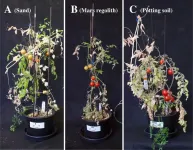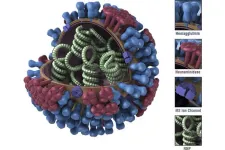(Press-News.org) (MEMPHIS, Tenn. – May 01, 2024) St. Jude Children’s Research Hospital scientists have identified specific DNA variants in the non-coding regions of the genome contributing to chemotherapy resistance in acute lymphoblastic leukemia (ALL). The results guided the team to unravel the mechanism behind a previously unknown contributor to therapeutic resistance. The discovery was enabled by combining new technologies to overcome previous limitations in understanding the non-coding genome, which could be adapted to other types of cancer and diseases. The findings were published today in Nature Communications.
Acute lymphoblastic leukemia (ALL) is the most common childhood cancer. Survival rates are over 94% due to modern therapy. However, those with relapsed or recurrent disease, often due to chemotherapy resistance, have a much poorer 30-40% survival rate.
The researchers studied resistance variants found in the non-coding genome, which makes up 98% of DNA and does not contain genes. Previous attempts to identify resistance mechanisms to chemotherapy focused on DNA that encoded genes. Looking directly at genes is simpler because non-coding DNA can have complex relationships with gene function, but the St. Jude group showed it is possible.
“We demonstrated that we now have the tools to find relevant non-coding genetic factors that contribute to chemotherapy resistance,” said corresponding author Daniel Savic, PhD, St. Jude Department of Pharmacy and Pharmaceutical Sciences. “The end goal is to understand the mechanisms of drug resistance so we can develop novel therapeutics and optimize existing chemotherapies based on the individual’s unique genetic makeup.”
Sorting through non-coding DNA to find the root of chemotherapy resistance
“The non-coding 98% of the genome contains instructions,” said co-first author Jackson Mobley, PhD, St. Jude Department of Pharmacy and Pharmaceutical Sciences. “If we are making a building, genes encode the iron bars, wires and concrete; non-coding DNA are the blueprints. We found the small changes in the blueprints that impact how well you respond to certain therapies.”
The group explored novel non-coding resistance variants by combining state-of-the-art technologies to examine patient samples and clinical data on treatment outcomes. In the past, research focused on a single gene or variant. However, combining high-throughput DNA sequencing methods allowed the St. Jude researchers to perform massively parallel variant screens. Those large screens enabled the testing of over 1,600 variants simultaneously to identify which were functional. That huge increase made the results more comprehensive, leading to the discovery of over 500 functional non-coding DNA variants associated with chemotherapy resistance.
“Our work represents the largest functional investigation of inherited non-coding variants associated with pharmacological traits, especially in ALL,” said co-first author Kashi Raj Bhattarai, PhD, St. Jude Department of Pharmacy and Pharmaceutical Sciences. “We verified that identified variants also have a similar effect in cell lines and patient samples.”
A novel resistance mechanism
By surveying many non-coding variants at once, the researchers could find the most impactful ones across different subtypes of ALL and connect them to a specific gene using innovative 3D genome mapping technologies. By finding the mechanism behind how variants in the non-coding genome affect target gene activity, they can figure out how it affects cancer’s response to treatment.
For example, the top variant from the screen led to the discovery of a new resistance mechanism. The resistance was to the chemotherapy drug vincristine. The researchers examined how DNA containing the functional variant physically looped to its target gene and which transcription factors, proteins that guide gene expression, were involved. The scientists found the variant bound near the gene for EIF3A, which is known to be involved in cell proliferation and survival. When they deleted the DNA containing the variant or reverted the mutation to the original sequence, they could alter the cells’ sensitivity to the chemotherapeutic agent vincristine.
The study serves as a proof of principle of how to take non-coding DNA variants and mechanistically connect them to a trait, such as chemotherapy resistance. That has been a long-standing issue holding back genomics research on inherited variants, from cancer to neurological issues.
“In any genome-wide association study, nearly all associated variants reside in the non-coding genome,” Savic said. “Therefore, connecting that variation to gene function and then to an actual trait, such as chemotherapy resistance or disease predisposition, is challenging. We showed that we have harnessed tools and technologies to systematically examine the non-coding genome and understand what it’s doing. We hope that our findings can be utilized to improve clinical outcomes in ALL patients.”
Authors and funding
The study’s other authors are Christopher Manring, Clara D. Bloomfield Center for Leukemia Outcomes Research; Elias Jabbour and Steven Kornblau, University of Texas MD Anderson Cancer Center; Elisabeth Paietta, Albert Einstein College of Medicine; Mark Litzow, Mayo Clinic; Wendy Stock, University of Chicago Medicine; Kelly Barnett, Daniel Ferguson, Baranda Hansen, Jonathan Diedrich, Brennan Bergeron, Satoshi Yoshimura, Wenjian Yang, Kristine Crews, Hiroto Inaba, Sima Jeha, Ching-Hon Pui, Cheng Cheng, Shondra Pruett-Miller, Mary Relling, Jun Yang and William Evans, St. Jude.
The study was supported by grants from the National Cancer Institute (R01CA234490, P30CA021765, U10CA180820, UG1CA232760562 and UG1CA189859), the National Institute of General Medical Studies (P50GM115279) and ALSAC, the fundraising and awareness organization of St. Jude.
St. Jude Media Relations Contacts
Chelsea Bryant
Desk: (901) 595-0564
chelsea.bryant@stjude.org
media@stjude.org
Michael Sheffield
Desk: (901) 595-0221
Cell: (901) 379-6072
michael.sheffield@stjude.org
media@stjude.org
Rae Lyn Hartley
Cell: (901) 686-2597
raelyn.rushing@stjude.org
media@stjude.org
St. Jude Children's Research Hospital
St. Jude Children's Research Hospital is leading the way the world understands, treats and cures childhood cancer, sickle cell disease and other life-threatening disorders. It is the only National Cancer Institute-designated Comprehensive Cancer Center devoted solely to children. Treatments developed at St. Jude have helped push the overall childhood cancer survival rate from 20% to 80% since the hospital opened more than 60 years ago. St. Jude shares the breakthroughs it makes to help doctors and researchers at local hospitals and cancer centers around the world improve the quality of treatment and care for even more children. To learn more, visit stjude.org, read St. Jude Progress, a digital magazine, and follow St. Jude on social media at @stjuderesearch.
END
Unraveling the roles of non-coding DNA explains childhood cancer’s resistance to chemotherapy
Scientists at St. Jude Children’s Research Hospital have discovered non-coding genetic variants contributing to chemotherapy resistance in acute lymphoblastic leukemia
2024-05-01
ELSE PRESS RELEASES FROM THIS DATE:
Marshall University announces new clinical trial studying the effect of ACL reconstruction on return to play in sports
2024-05-01
HUNTINGTON, W.Va. – The Marshall University Joan C. Edwards School of Medicine is now accepting applicants for an observational trial focused on fertilized anterior cruciate ligament (ACL) reconstruction.
Unlike traditional ACL repairs, fertilized ACL surgery uses a biologic concentrate of the patient’s stem cells, bone marrow and autograft bone along with an internal brace with the goal of stabilizing and expediting the healing process.
“Past patients of the fertilized ACL have already shown shorter recovery times with no known additional risks to the patient,” said Chad D. Lavender, M.D., ...
New York State is vulnerable to increasing weather-driven power outages, with vulnerable people in the Bronx, Queens and other parts of New York City being disproportionately affected
2024-05-01
New York State is vulnerable to increasing weather-driven power outages, with vulnerable people in the Bronx, Queens and other parts of New York City being disproportionately affected.
####
Article URL: https://journals.plos.org/climate/article?id=10.1371/journal.pclm.0000364
Article Title: Powerless in the storm: Severe weather-driven power outages in New York State, 2017–2020
Author Countries: United States
Funding: This work was supported by the National Institute for Environmental Health Sciences (NIEHS) P30 ES009089 ...
Time-restricted eating and high-intensity exercise might work together to improve health
2024-05-01
Combining time-restricted eating with high-intensity functional training may improve body composition and cardiometabolic parameters more than either alone, according to a study published May 1, 2024 in the open-access journal PLOS ONE by Ranya Ameur and Rami Maaloul from the University of Sfax, Tunisia, and colleagues.
Changes in diet and exercise are well-known ways to lose weight and improve cardiometabolic health. However, finding the right combination of lifestyle changes to produce sustainable results can be challenging. Prior studies indicate that time-restricted eating (which limits when, but not what, individuals eat) and ...
Simulations of agriculture on Mars using pea, carrot and tomato plants suggest that intercropping, growing different crops mixed together, could boost yields in certain conditions
2024-05-01
Simulations of agriculture on Mars using pea, carrot and tomato plants suggest that intercropping, growing different crops mixed together, could boost yields in certain conditions
###
Article URL: https://journals.plos.org/plosone/article?id=10.1371/journal.pone.0302149
Article Title: Intercropping on Mars: A promising system to optimise fresh food production in future martian colonies
Author Countries: The Netherlands
Funding: The author(s) received no specific funding for this work. END ...
New computer algorithm supercharges climate models and could lead to better predictions of future climate change
2024-05-01
Earth System Models – complex computer models which describe Earth processes and how they interact – are critical for predicting future climate change. By simulating the response of our land, oceans and atmosphere to manmade greenhouse gas emissions, these models form the foundation for predictions of future extreme weather and climate event scenarios, including those issued by the UN Intergovernmental Panel on Climate Change (IPCC).
However, climate modellers have long faced a major problem. Because Earth System Models integrate many complicated processes, they cannot immediately run a simulation; they must first ensure that it has reached a stable equilibrium ...
These communities are most vulnerable to weather-related power outages in New York State
2024-05-01
Weather-related power outages in the United States have become nearly twice as common in the last ten years compared to the previous decade. These outages, which can last most of a day, are more than an inconvenience: lack of power and related indoor temperature discomfort can exacerbate health conditions; lack of power also endangers the lives of people who are reliant on electricity-powered medical devices and/or elevators.
A new study led environmental health scientists at Columbia University ...
New strategy could lead to universal, long-lasting flu shot
2024-05-01
DURHAM, N.C. -- Duke researchers have opened a new avenue in the attack against influenza viruses by creating a vaccine that encourages the immune system to target a portion of the virus surface that is less variable.
Their approach worked well in experiments with mice and ferrets and may lead to more broadly-protective influenza vaccines and less reliance on an annual shot tailored to that year’s versions of the virus. Even with vaccines, influenza kills about a half-million people each year around the world.
This new vaccine approach, described May 1 in the journal Science Translational ...
Mystery behind huge opening in Antarctic sea ice solved
2024-05-01
EMBARGOED: Not for Release Until 14:00 U.S. Eastern Time (19:00 UK Time) on Wednesday, 01 May 2024
Mystery behind huge opening in Antarctic sea ice solved
Researchers have discovered the missing piece of the puzzle behind a rare opening in the sea ice around Antarctica, which was nearly twice the size of Wales and occurred during the winters of 2016 and 2017.
A study published today [1 May 2024] in Science Advances reveals a key process that had eluded scientists as to how the opening, called a polynya, was able to form and persist for ...
Brain imaging study reveals connections critical to human consciousness
2024-05-01
Human consciousness requires arousal (i.e., wakefulness) and awareness
Brain imaging studies over the last decade have produced connectivity maps of the cortical networks that sustain awareness, but maps of the subcortical networks that sustain wakefulness are lacking, due to the small size and anatomic complexity of subcortical structures such as the brainstem
In a magnetic resonance imaging (MRI) study that integrated high-resolution structural and functional connectivity data, researchers mapped a subcortical brain network that is believed to integrate arousal and awareness in human consciousness
In a paper titled, “Multimodal ...
Do earthquake hazard maps predict higher shaking than actually occurred?
2024-05-01
A new study by Northwestern University researchers and coworkers explains a puzzling problem with maps of future earthquake shaking used to design earthquake-resistant buildings.
Although seismologists have been making these maps for about 50 years, they know very little about how well they actually forecast shaking, because large damaging earthquakes are infrequent in any area.
To learn more, the Northwestern research team compiled shaking data from past earthquakes. These include CHIMP (California Historical Intensity Mapping Project) ...
LAST 30 PRESS RELEASES:
Scientists boost cell "powerhouses" to burn more calories
Automatic label checking: The missing step in making reliable medical AI
Low daily alcohol intake linked to 50% heightened mouth cancer risk in India
American Meteorological Society announces Rick Spinrad as 2026 President-Elect
Biomass-based carbon capture spotlighted in newly released global climate webinar recording
Illuminating invisible nano pollutants: advanced bioimaging tracks the full journey of emerging nanoscale contaminants in living systems
How does age affect recovery from spinal cord injury?
Novel AI tool offers prognosis for patients with head and neck cancer
Fathers’ microplastic exposure tied to their children’s metabolic problems
Research validates laboratory model for studying high-grade serous ovarian cancer
SIR 2026 delivers transformative breakthroughs in minimally invasive medicine to improve patient care
Stem Cell Reports most downloaded papers of 2025 highlight the breadth and impact of stem cell research
Oxford-led study estimates NHS spends around 3% of its primary and secondary care budget on the health impacts of heat and cold in England
A researcher’s long quest leads to a smart composite breakthrough
Urban wild bees act as “microbial sensors” of city health.
New study finds where you live affects recovery after a hip fracture
Forecasting the impact of fully automated vehicle adoption on US road traffic injuries
Alcohol-related hospitalizations from 2016 to 2022
Semaglutide and hospitalizations in patients with obesity and established cardiovascular disease
Researchers ‘listen in’ to embryo-mother interactions during implantation using a culture system replicating the womb lining
How changing your diet could help save the world
How to make AI truly scalable and reliable for real-time traffic assignment?
Beyond fragmented markets: A new framework for efficient and stable ride-pooling
Can shape priors make road perception more reliable for autonomous driving?
AI tracks nearly 100 years of aging research, revealing key trends and gaps
Innovative techniques enable Italy’s first imaging of individual trapped atoms
KIER successfully develops Korea-made “calibration thermoelectric module” for measuring thermoelectric device performance
Diversifying US Midwest farming for stability and resilience
Emphasizing immigrants’ deservingness shifts attitudes
Japanese eels, climate change, and river temperature
[Press-News.org] Unraveling the roles of non-coding DNA explains childhood cancer’s resistance to chemotherapyScientists at St. Jude Children’s Research Hospital have discovered non-coding genetic variants contributing to chemotherapy resistance in acute lymphoblastic leukemia




